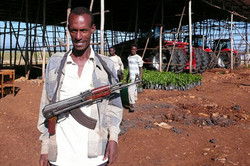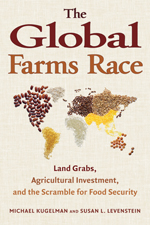
Sustainable Security | July 2012
The global land rush: Catalyst for resource-driven conflict?
Michael Kugelman
On May 11, the UN approved new international rules to govern how land is acquired abroad. These Voluntary Guidelines (VGs), the outcome of several years of protracted negotiations, are a response to growing global concern that nations and private investors are seizing large swaths of overseas agricultural land owned or used by small farmers and local communities for food, medicinal, or livelihood purposes. FAO head Jose Graziano da Silva describes the VGs as “a starting point that will help improve the often dire situation of the hungry and poor.”
It’s hard to quibble with the intent of the guidelines. They call for, among other things, protecting the land rights of local communities; promoting gender equality in land title acquisition; and offering legal assistance during land disputes.
Unfortunately, however, any utility deriving from the VGs will be strictly normative. As their name states explicitly, they are purely optional. A toothless set of non-obligatory rules will prove no match for a strategy that is striking both for its scale and for the tremendous power of its executioners.
Oxfam estimates that nearly 230 million hectares of land (an area equivalent to the size of Western Europe) have been sold or leased since 2001 (with most of these transactions occurring since 2008). According to GRAIN, a global land rights NGO, more than 2 million hectares were subjected to transactions during the first four months of 2012 alone. One of the largest proposed deals—an attempt by South Korea’s Daewoo corporation to acquire 1.3 million hectares of farmland in Madagascar—failed back in 2009. Still, even larger investments are being planned today, including a Brazilian effort to acquire a whopping 6 million hectares of land in Mozambique to produce corn and soy (Mozambique offered a concession last year).
The Brazil-Mozambique deal illustrates another striking element of scale: transactions are not limited to wealthy, developed nations preying on the developing world. Developing nations in Africa, Latin America, and Africa are acquiring farmland as well, and developed countries like New Zealand are some of the targets. Nevertheless, capital-rich countries in East Asia and the Gulf (along with large western corporations and agribusiness firms) are indeed spearheading the majority of the investments, with most of the land located in impoverished African states.
Who are these investors? They include the likes of China and Saudi Arabia, along with companies such as Goldman Sachs. According to the Oakland Institute, prestigious universities such as Harvard and Vanderbilt are joining the farmland craze as well. These wealthy nations and institutions are acquiring land in corruption-prone African countries—such as Sudan, Ethiopia, Kenya—and in areas populated by the rural destitute.
Given the power imbalances at play—wealthy nations and institutions feasting on land in desperately poor and often undemocratic countries—it is folly to assume that land-seekers will suddenly embrace, en masse, a set of voluntary rules promoting sustainable and equitable investor practices. Land-lusting nations and investors are driven by immediate needs—promoting food security back home and making profits, respectively—and they have neither the incentive nor the obligation to slow down and adjust their investments in response to the wishes of distant international bureaucrats.
What, then, can we expect from this race for the world’s farmland? Proponents of large-scale land acquisitions predict positive consequences in countries hosting investments: Better technologies for local farmers, job opportunities for rural laborers, and enhanced crop yields. Critics paint a drastically different picture. They warn that rural communities will be robbed of land that they have long owned or accessed, with devastating ramifications for food security and livelihoods.
While some preliminary research supports the positive narrative (a German government study, for example, projects that a sugar production project in Mali will create 5,000 jobs), the bulk of available data (which includes analyses from the World Bank, International Land Coalition, and Oxfam) buttresses the negative narrative. In Sierra Leone and Mozambique, investors’ promises of jobs to smallholders have gone unfulfilled. And in Ethiopia, an Indian conglomerate is producing food for export on land previously used to cultivate an indigenous staple crop.
Perhaps the most troubling implication of all, however, is the potential for conflict. While it is risky to attribute direct causation between natural resource inequity and conflict, there are clear links between resource security and national security. The case of India is illustrative, because, as I have written previously, many of its national security concerns are tied to natural resource issues. The nation’s Maoist insurgency—which Delhi often refers to as its “gravest internal security threat”—is based in Indian coal country, and is fueled in great part by the belief that Indian firms and the government exploit coal resources with little regard for the needs of locals. Tensions with Pakistan are tied to water, thanks to long-standing disagreements over riverwater allocations in Kashmir. And Delhi’s concerns about China’s activities in the Indian Ocean Region (IOR) are linked to energy, because China, like India, is scouring the IOR for the resource. Furthermore, India-China border tensions occur over the Himalayan Indian state of Arunachal Pradesh, an unusually water-rich area and hence strategic territory for both water-starved nations.
So far, the only example of large-scale land acquisitions contributing to widespread instability is Madagascar, where the aforementioned 2009 Daewoo bid caused a local outcry, helping spark public protests that ultimately brought down the government that had agreed to the deal (the new government immediately annulled it). Still, several land accords have sparked localized conflict. Last year, a Ugandan mob, furious about an Indian firm’s decision to clear space in a rainforest for sugarcane production, killed an Indian man. The threat of future land-induced conflict is very real. Last year Kenyans told of being forcibly evicted from Tana Delta to allow investors to build a sugar plantation, and promised to fight back “with guns and sticks….It will be war.”
Ominously, these land acquisitions often occur in nations already riven by conflict, and so the volatile mix of factors at play—land, food insecurity, and poverty—could well trigger more strife. Take Pakistan, for example, where the ability of the Taliban to take control of the Swat region several years ago was facilitated by its exploitation of land-based class divisions. With Islamabad having offered a 100,000-person-strong private security force to protect foreign land investor holdings, the possibility of violent land-based conflict in the deeply food-insecure nation is particularly acute (however, there is no evidence as of yet of major foreign land acquisitions in Pakistan). Consider Indonesia as well. Here, a Saudi firm has acquired more than a million hectares of land for food production on a Jakarta-controlled estate in Papua, a province embroiled in separatist insurgency. With non-Papuans expected to be imported in to provide labor for this project, the chance of ethnic-driven unrest is high.
Don’t expect these risks and threats to disappear anytime soon, because there is little reason to expect the investments themselves to cease in the near-term. The factors that first sparked these land acquisitions during the global food crisis of 2007-08—population growth, high food prices, unpredictable commodities markets, water shortages, and above all a plummeting supply of arable land—remain firmly in place today.
Still, while the troubling outcomes of these deals cannot be wished away, their harmful effects can be blunted. And this can best be done not by announcing nice-sounding yet non-binding international guidelines, but rather by establishing firm and clear national laws and policies in the countries hosting investments.

National governments should establish robust land-use regulations that emphasize food security and resource equity; offer legal assistance to local farmers to ensure that their rights are safeguarded in the contracts governing land deals; and strengthen land registries so that land is better protected from foreign exploitation.
Granted, given that many of the governments hosting these investments are not known for promoting the well-being of their masses, this all represents a tall order. Yet given the high stakes, it is also a necessary order. The world is already overburdened by food insecurity, unemployment, and conflict; let’s hope that appropriate measures are taken to ensure that large-scale land acquisitions don’t exacerbate these global scourges.
Michael Kugelman is the South and Southeast Asia associate at the Woodrow Wilson International Center for Scholars in Washington DC, and lead editor of The Global Farms Race: Land Grabs, Agricultural Investment, and the Scramble for Food Security, to be published by Island Press this coming fall. He can be contacted at [email protected] or on Twitter @michaelkugelman












